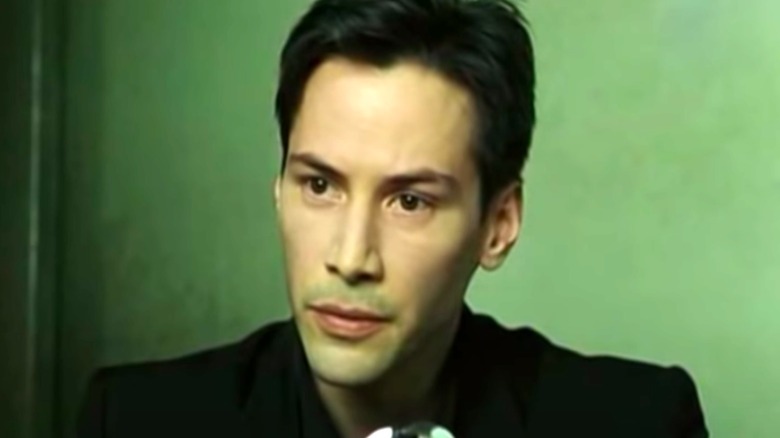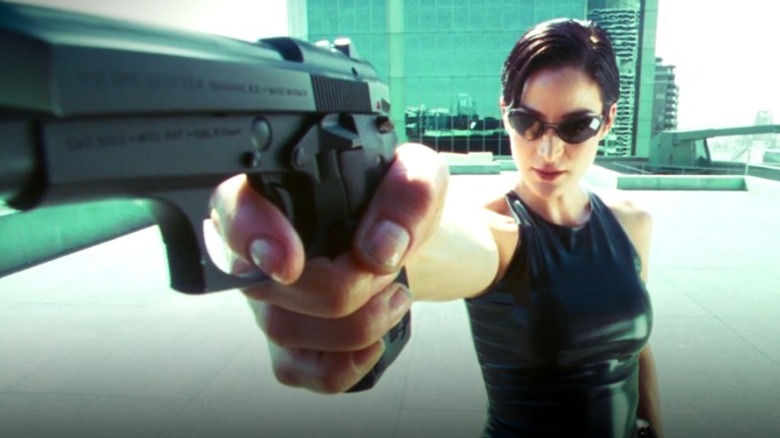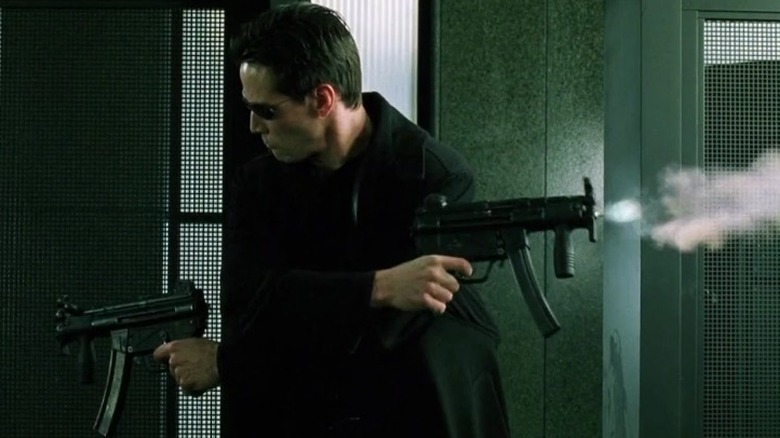The Matrix Scene That Aged Poorly
When "The Matrix" debuted in the early spring of 1999, it not only blew audiences away with its then-revolutionary special effects and distinct cinematography, it also struck a chord with viewers who were simultaneously growing more dependent on, and more skeptical of, technology. "The Matrix" spoke to a generation for whom cell phones, home computers, and the internet were all developing with exponential speed — they hadn't been born into a world with this pocket technology, but found themselves surrounded by it within a matter of years. 22 years later, the film's use of that complex humans vs. machines dynamic as an extended metaphor still speaks to audiences, possibly even more so. It's no wonder, then, that fans are hungrier than ever for a follow-up.
Of course, as with almost any film over two decades old — even those lauded for being ahead of their time — there's a few elements in "The Matrix" that appear slightly different when viewed through the lens of 2021.
No, we're not talking about the film's excessive use of PU, pleather, and patent leather — all of which is A, still awesome, and B (if the highly scientific laws of fashion trend recurrence are to be trusted) should be back in style by the fall of 2022 anyway — nor are we talking about some of its more inevitably dated special effects. We're also not talking about what the far corners of the political and ideological spectrum have done with the "red pill" symbolism, since co-creator Lilly Wachowski has made her thoughts on that deeply flawed co-opting abundantly clear (via Twitter).
Ultimately, "The Matrix" holds up astonishingly (almost prophetically) well, even all these years later. There's one scene, though, that hits a little differently for modern audiences.
The rescue scene in "The Matrix" hits differently in 2021
Given what we now know about the film as an allegory for the transgender experience (via Vox), there's a lot about "The Matrix" that actually speaks even more poignantly to audiences in 2021. To say it "really holds up" is an understatement.
Nonetheless, there's one scene that's jarring to modern-day audiences, not because of its overt violence, but because of its approach to the depiction of, specifically, gun violence — and that's when Trinity (Carrie-Anne Moss) and Neo (Keanu Reeves) rescue Morpheus (Laurence Fishburne) from Agent Smith.
Less than a month after "The Matrix" released (via History), Colorado teens Eric Harris and Dylan Klebold shot and killed 13 of their Columbine High School classmates and wounded 20 others in would become an all-too-frequent occurrence in the United States. To be clear, there is no causation here. Gun violence in "The Matrix" didn't cause these two teens to shoot their classmates. Nor is cinematic gun violence responsible for the fact that (for instance) just two years ago, as the BBC reports, "killings involving a gun accounted for nearly three quarters of all homicides in the US." Given, however, the current increase in awareness of the issue coupled with the increasingly contentious debate surrounding proposed legislation to address it, the scene's focus on the weapons themselves (as opposed to the heroes wielding them) reads differently.
Had the film come out in, say, fall 1999 — and had the gun glamorization belonged to the villains rather than the heroes — it would be easier to view the scene as a harsh commentary. Instead, the scene's hyper-focus on Neo's arsenal of weaponry, paired with its accentuation of Trinity's gun, is perhaps the one element in the film that places it firmly in a more naive era.
In recent years, Hollywood has grappled with its glorification of guns
In recent years, Hollywood has had a series of reckonings with depictions of gun violence. As Today reported in 2012, "After the shootings at a showing of 'The Dark Knight Rises' [...] a trailer for the film 'Gangster Squad' was pulled from theater use due to a scene in which gunmen walk through a theater screen shooting into the audience." That same year, following the massacre at Sandy Hook elementary school, Paramount chose to cut a particularly flashy gun scene from the "Jack Reacher" trailer, while Lantern Entertainment (then, the Weinstein Co.) chose to cancel its Los Angeles premiere of Tarantino's "Django Unchained" (via Hollywood Reporter).
That said, there are two important things to remember in regard to the gun-happy rescue scene in "The Matrix." First, the film very intentionally reminds both Neo and viewers that the matrix itself is a simulated reality. Since the only thing about the matrix that translates to reality is actual, physical death, its heavy use of lethal weaponry can't — at least, in theory — be taken any more seriously than the unreality of the spoon that Neo can bend once he accepts that it's not actually there. The second is that, despite strong arguments on both sides, even the director of the Johns Hopkins Center for Gun Policy and Research himself, Daniel Webster, has said that "violent media is not where I look when I consider how to reduce gun violence and homicides" (via Scientific American).
Ultimately, while gun violence in Hollywood can't possibly be held responsible for the confluence of factors contributing to the United States' gun problem, there's still something about a scene that makes automatic weaponry look so very cool and sleek that feels slightly out of place in 2021.


